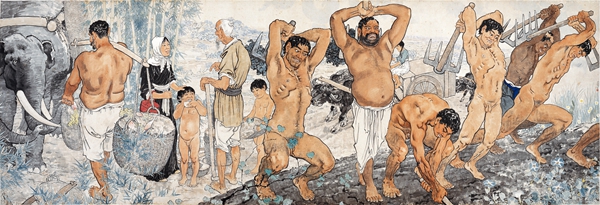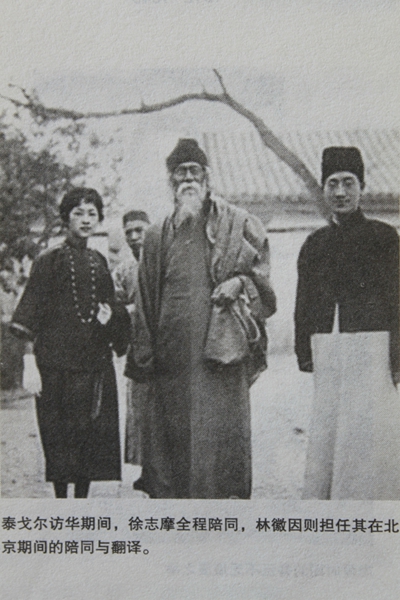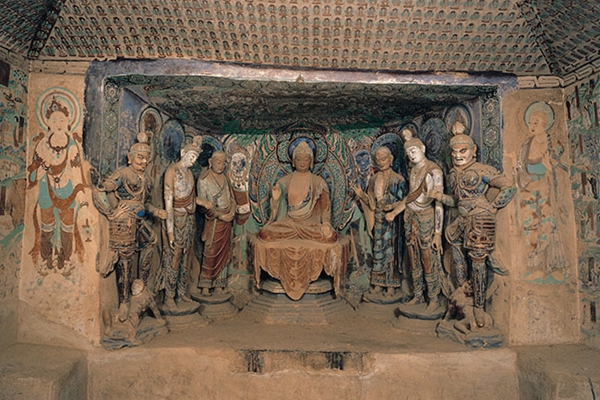Handshaking Across the Himalayas
A Glimpse of China-India Cultural Exchanges

Yugong Removes Mountains (Chinese painting) XU Beihong

Tagore takes photos with LIN Huiyin and XU Zhimo during his visit to China

In April, 1924, Indian poet Tagore visited Beijing, took photo with Liang Sicheng (No.1 from left), Lin Huiyin (No.2 from right) and Xu Zhimo (No.1 from right).

Cave 45, Dunhuang Mogao Grottoes-Caisu Yipu(Prime time of Tang Dynasty)

Tagore (Chinese painting) XU Beihong
It’s already been three times in less than four months--- what I am talking about is the Bollywood movies entered into the Chinese cinemas--- as Hindi Medium, a movie focusing on the issue of education under the gap between the rich and the poor in India’s society, prevails across China, the 2018 China International Film Festival, jointly organized by China Federation of Literary and Art Circles and India-China Film Friendship Association has been held in Jaipur, a historical and cultural resort and the capital city of Rajasthan. A series of Chinese films winning both box office and reputation have showcased the achievement of China’s filmmaking industry to the Indian audiences, including Monster Hunt, Wolf Totem, Go away Mr. tumour, Xuan Zang, The Grandmaster and others.
The cultural exchanges between Chinese and Indian films have been long-established—as early as the 1970s and 1980s, classic Indian films, such as Caravan and The Tramp were most popular in China. And in the moment, with the screening of Indian movies in China, such as Secret Superstar,BajrangiBhaijaan, Dangal, the film culture exchanges between the two countries have ushered in a broader space.
Not only movies, the cultures of China and India have been marching hand in hand since the beginning of the new century. Even earlier than the new century---as some experts in ChinaIndia relations have analyzed: China and India sharing borders had few wars in thousands of years of history, during which the cultural integration emerged substantially, most rare in the world history.The reason is that the cultural and artistic exchanges between the two countries have always been the same as the vibrant rivers, flowing from the Tibetan Plateau and the Himalayas to the hearts of the two peoples.
Geographical similarities, humanities closeness. China and India have been keeping the "cultural empathy" for thousands of years. For more than two thousand years, from the Qin and Han dynasties to the Sui and Tang dynasties and to the Song and Yuan dynasties, the culture of the two countries has always been inclusive and complementary. The China-India communication initiated in the Qin Dynasty, gradually became more frequent during the Han and Tang dynasties, culminated in the Sui and Tang dynasties and became more in-depth during the Song and Yuan dynasties.In this 2000-year history of exchanges, cultural exchanges have been remaining the pillars.As Mr. LU Xun once said: "India has been well linked with China since the ancient times, it’s thinking, belief, moral and arts have benefited China as brother."--- While India's Buddhism, music, dance, astronomical calendar, literary language, architecture and sugar making technologies were introduced into China, China’s papermaking, silk, porcelain, tea and music were also introduced to India.China’s Twenty-Four Histories and the documents and travel notes left, a great monk after his sailing course have become the basis for India’s building of ancient history.
"India is thousands miles away to the southeast of Daxia, remaining primitive alike Daxia. Humid weather, people are good at riding elephants, and the country is bordering water…"Chinese people's beginning to know India is based on the clear record of Shi Ji·DawanLiezhuan, an imaginary, distant India with hot climate then appeared in the eyes of Chinese people.The document records that ZHANG Qian discovered the silk cloth and bamboo sticks produced in China's Sichuan area in Daxia (present-day Iran and Afghanistan). Locals told him that these were India through trading. The two pieces of information in the Shi Ji are the earliest and most reliable written records of cultural exchange between China and India.
From the records of the Shi Ji alone, we know that right before ZHANG Qian’s traveling to the Western Regions, China's southwest region and India already established trade relations. There is no doubt that such contacts must be based on mutual understanding and trust after a long period of contact and interaction.
The birth and development of Buddhism has led to more frequent and close cultural exchanges between the two countries. Upon mentioning the history of bilateral Buddhist exchanges, the contribution by Kumārajīva cannot be ignored.He was proficient in Sanskrit and Chinese. In his eight years staying in Chang'an, he translated a total of 98 Buddhist scriptures from India, totaling 425 volumes. Many of the important Buddhist texts, including the Mahāprajāpāramitā-sūtra and Saddharmapundarika-sutra were translated by him. His translation efforts not only spread Buddhist classics, but also greatly enhanced the level of Sanskrit amongst Chinese scholars.The fact that Indian monks came to China for missionary has also led to the feats of Chinese monks continuing to travel to India to learn from monasteries. In AD 399, Fajin and other officials from the Eastern Jin dynasty set out from Chang’an and traveled to more than 20 countries through the Western Regions to India to collect a large number of Sanskrit classics. In their 14-year-long journey, he has traveled more than 30 countries, and co-translated Mahasangha-vinaya, upasam!panna, Maha^-parinirva^n!a and ZaCang Jing with his peers and composed the Journey to Buddhist Countries, a work of his travel log.
FA Xian’s trip to India has written a brilliant chapter in the history of Chinese Buddhism and the history of cultural exchanges between China and India. His pioneering spirit has inspired generations of Chinese monks to seek for the West.In the first year of Zhenguan of Tang dynasty, Xuan Zang, the great monk,traveled 50,000 miles to the West all by himself to explore the divergent approach of Buddhism factions, and went through the hardships to reach the Nalanda Temple, the Buddhist center of India. In the 17 years all through that period, he learned all various theories of Mahayana and HinayanaBuddhism, bringing back 150 Buddhist relics, 7 statues of Buddha and 657 classics. He has long been engaged in the translation of Buddhist sutras and has become a Buddhist monk in the history of Buddhism, together with other great translators as Kumārajīva, paramārtha and Amoghavajra. His book, The Western Regions of the Tang Dynasty, describes the mountains, valleys, properties, customs and etc. of the 110 countries he has personally experienced and the 28 countries he has heard of. Xuan Zang traveled to India to the west and its cultural influence spread far away to the land of China, Japan, South Korea, India and even the whole world. Just as India’s historian Ali wrote to JIXianlin in 1978, “If there were no great works of FA Xian, XUAN Zang and MA Huan, it is utterly impossible to reconstruct the history of India."
While China was drawing the essence of religious culture and art from India, the Chinese literature was also influenced by its Indian counterpart. Fables, fairy tales and short stories of India have flooded into China from the Northern and Southern Dynasties. By the Tang Dynasty, Indian literature had an important influence on the most characteristic literary genre of the Tang Dynasty—the legendary literary, which was like the Indian classical literature, using a single object as a clue to connect several irrelevant stories together. In terms of content, Chinese literature has introduced elements, such as ghosts, dragon girls and dreams to India.
Meanwhile, the four great inventions in ancient China also 39nourished the development of Indian civilization. With the opening of the Silk Road, Chinese paper has gradually flown abroad, becoming an important commodity in the Silk Road. Before the 11th century, there was no paper in India. They used birch bark as Indian Buddhist scriptures were almost all copied by coryphaumbraculifera; China's paper and papermaking techniques were first introduced from the inner land to Xinjiang and then to India. After papermaking was introduced to India, the number of paper copies has increased gradually.
Until the late Qing dynasty, India and China successively became colonies and semi-colonies of Western powers, but there was no formal and direct cultural exchange. Until 1924, the Indian poet Robindranath Tagore led a six-member delegation to China as a representative of the international university by the invitation of Chinese scholars XU Zhimo, LIANG Qichao and others. The nearly interrupted cultural contacts have resumed while bringing the cultural exchanges surpassing the religious culture.
As the exclusive visitor from Asian colonial countries during the period of the Republic of China, literary exchange, though not the main purpose of Tagore’s visit, had a major impact on the direction of Chinese literature during the transition period. As the first Asian Nobel Prize winner in literature, Tagore’s arrival has ignited the upsurge of translation and research in Chinese academic circles. XU Zhimo, WANG Tongzhao, BING Xin and other loyal followers, who were infatuated with his poetry, exchanged their experiences from time to time. The course of literary creation due to passion to Tagore has later led the development of Chinese literature, especially in terms of poetry reform.
During his stay in China, XU Zhimo, LINHuiyin and others have performed his play Chitra in English to celebrate his 64thbirthday,becoming the “first” of Indian drama in the history of Chinese and Indian culture. Peking Opera master MEI Lanfang performed Luo Shen by the demand of Tagore, who praised MEI’s superb performance and hoped that he would perform in India to give the Indian audiences a glimpse of the style of Chinese Peking Opera; meanwhile, MEI Lanfang adopted the Tagore’s suggestions as employing the colors of red, green, yellow, black and purple to present the beautiful scenes of mythology and poet's richimagination, and improved the scene to make it more closely to the plot with good results.
Tagore’s interest in Chinese painting was most strong and his visit has also been warmly welcomed by the Chinese painting community. When arriving in Shanghai, the young artist LI UHaisu has created two sketches for him. The Hangzhou Xiling Seal Club gave him a seal with the word "Tagore" inscribed in three Chinese characters. And the Beijing painting community specially organized a welcome exhibition.
Tagore’s visit to China not only prompted a group of Chinese students to study in India, but the Chinese Academy of Indian International University supported by Tagore also invited many Chinese scholars and artists to visit the country, providing convenience to a large number of people from Chinese cultural and artistic circles for exchanges in India. One of the most famous examples is that the painter XU Beihong was invited by Tagore to serve as a visiting professor at the Chinese Academy from 1939 to 1940. It was also the period that XU was in an unprecedented stage of high production.During his time in India, XU Beihong has painted a lot of sketches and drawings into his collections, ranging from local customs to animals, portraits of great people to landscapes, school music lessons to self-portraits, and created works as the Portrait of Tagore, Gandhi, India Women, The Forest of the Himalayas and others.Many of his characters in the famous work How Yukong Moved the Mountains were performed by Indians. Students at the Indian International University in Saatiniketan were even competing to be his models. In the painting, there was a person who was very similar to LU Zhishen, who was repeatedly depicted by XUBeihong. His prototype was a chef at the school, who was very happy whenever XU asked him to be themodel.Some people once asked why XU Beihong wanted to add Indian images to Chinese historical works. He replied: "Although Indians, they are all hardworking people, their image is different from that of the Chinese people, but the significance is the same."
Tagore’s visit to China, just like his Chinese name "ZHU Zhendan", has rebuilt the almost-interrupted bridge of culture between China and India. Nearly a hundred years have passed,we can still feel the far-reaching impact it has brought to China-India cultural exchanges upon reviewing this cultural event.After the founding of New China and the independence of India, the cultural exchanges between the two countries flourished again. The recent years have witnessed numerous "Cultural Month", "Friendship Year", food festivals, cultural relics exhibitions, new book launches and seminars between China and India.However, the cultural significance of "ZHU Zhendan" is just like CHINDIA (Great Connection between China and India) pioneered by the famous Indian economist Jairam Ramesh hoping to remove the boundary between the two nations, and turn the two sides into a harmonious body of culture.
Recalling the invaluable history of cultural exchanges between China and India, it is not difficult to discover that the cultural exchanges among the peoples are undoubtedly the natural foundation of cooperation and the favorable resources for common progress. The profound cultural accumulation and long history tradition are the precious spiritual wealth of the peoples of China and India.Since the 21st century, both countries have grasped the promisingopportunity for economic growth, driving all countries globally to turn to Asia, and the two great ancient civilizations with large populations, vast territory and abundant resources. It is under heated discussion that the 21st century belongs to China or India. It seems that this question is far from finding an answer. Today, both China and India are concentrating on the great rejuvenation of the nations.
Diplomacy of great nations lies in heart-to-heart communication. In the context of the global community of shared future, the non-governmental exchanges between China and India are capable of better highlighting the cultural advantages of "using wisdom to manage disputes, realizing cooperation and development via feelings", and further strengthening the friendly bilateral relationship. The Yellow River and the Gangesrush forward forever like it wasstated in livemint, an Indian website: this is a "Handshaking Across the Himalayas".














